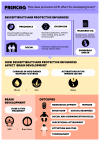Preterm birth as a determinant of neurodevelopment and cognition in children (PRENCOG): protocol for an exposure-based cohort study in the UK
- PMID: 39284691
- PMCID: PMC11409314
- DOI: 10.1136/bmjopen-2024-085365
Preterm birth as a determinant of neurodevelopment and cognition in children (PRENCOG): protocol for an exposure-based cohort study in the UK
Abstract
Introduction: Preterm birth (PTB) is strongly associated with encephalopathy of prematurity (EoP) and neurocognitive impairment. The biological axes linking PTB with atypical brain development are uncertain. We aim to elucidate the roles of neuroendocrine stress activation and immune dysregulation in linking PTB with EoP.
Methods and analysis: PRENCOG (PREterm birth as a determinant of Neurodevelopment and COGnition in children: mechanisms and causal evidence) is an exposure-based cohort study at the University of Edinburgh. Three hundred mother-infant dyads comprising 200 preterm births (gestational age, GA <32 weeks, exposed) and 100 term births (GA >37 weeks, non-exposed), will be recruited between January 2023 and December 2027. We will collect parental and infant medical, demographic, socioeconomic characteristics and biological data which include placental tissue, umbilical cord blood, maternal and infant hair, infant saliva, infant dried blood spots, faecal material, and structural and diffusion MRI. Infant biosamples will be collected between birth and 44 weeks GA.EoP will be characterised by MRI using morphometric similarity networks (MSNs), hierarchical complexity (HC) and magnetisation transfer saturation imaging (MTsat). We will conduct: first, multivariable regressions and statistical association assessments to test how PTB-associated risk factors (PTB-RFs) relate to MSNs, HC and or MTsat; second, structural equation modelling to investigate neuroendocrine stress activation and immune dysregulation as mediators of PTB-RFs on features of EoP. PTB-RF selection will be informed by the variables that predict real-world educational outcomes, ascertained by linking the UK National Neonatal Research Database with the National Pupil Database.
Ethics and dissemination: A favourable ethical opinion has been given by the South East Scotland Research Ethics Committee 02 (23/SS/0067) and NHS Lothian Research and Development (2023/0150). Results will be reported to the Medical Research Council, in scientific media, via stakeholder partners and on a website in accessible language (https://www.ed.ac.uk/centre-reproductive-health/prencog).
Keywords: Developmental neurology & neurodisability; Immunity; Machine Learning; Magnetic Resonance Imaging; Neonatal intensive & critical care; Physiological Stress.
© Author(s) (or their employer(s)) 2024. Re-use permitted under CC BY. Published by BMJ.
Conflict of interest statement
Competing interests: REM is a scientific advisor to Optima Partners and the Epigenetic Clock Development Foundation. NM is the chief investigator for the National Neonatal Research Database. LM has received speaker and consultancy fees from Illumina.
Figures



References
Publication types
MeSH terms
Grants and funding
LinkOut - more resources
Full Text Sources
